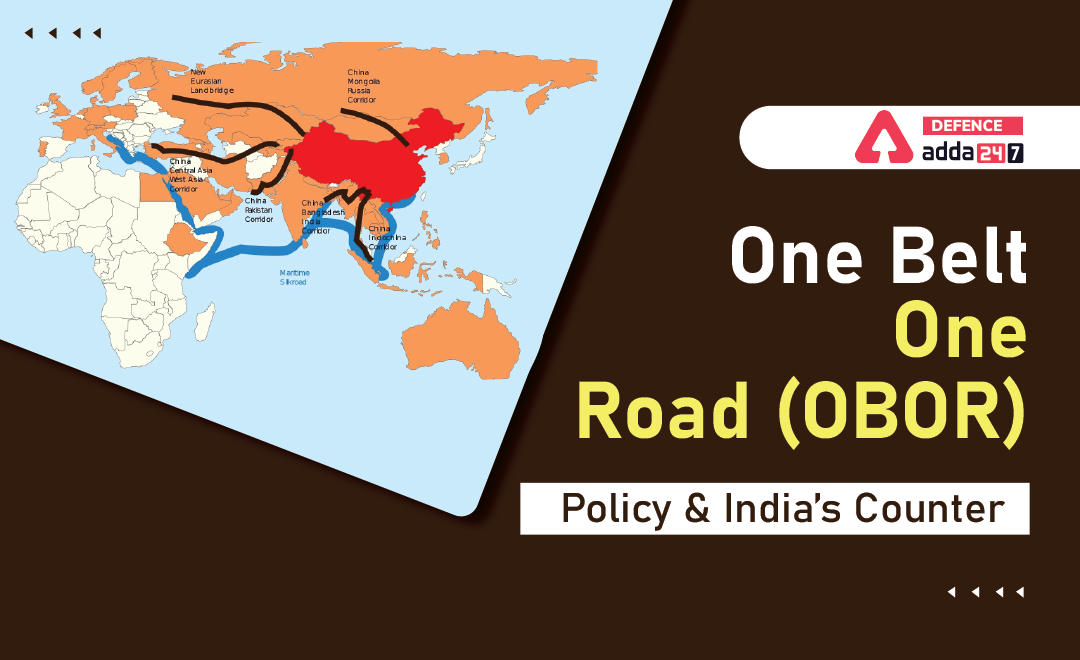One Belt One Road
One belt One Road is an ambitious project of china that focus on connectivity and cooperation among multiple countries spread across majorly three continents that is, Asia, Europe and Africa. It covers almost 80 countries.
It involves building networks of roadways, railways, maritime ports, power grids, oil and gas pipelines and other related infrastructure projects. It an initiative of china to revive its old Silk trade route 1 which led to the social and economic development of the countries involved in this group. One Belt One Road consists of many sub-plans like CPEC (China Pakistan Economic Corridor), Bangladesh-China-India-Myanmar, 21st Century maritime silk route, etc.
With all these initiatives China aspires to double its GDP and to take himself to the level of moderately developed country. But China has some hidden agendas associated with it, as china wants to prove its dominance and hegemony all over the world so to mark its dominance it has planned to invest such a big amount in other countries. What looks very considerate from outside is actually very harmful for a country as we have just witnessed in Sri-Lanka, where the country has lost its economic balance and even the whole government is not functioning due to poor state of the nation and in this china plays a substantial role. Providing loans to Sri-Lanka in the name of investing in ambitious projects which even failed miserably left the nation in helpless condition.
Not just economically China is trying to prove its supremacy but in the terms of Defense china wants to be the most powerful and for that, this project is a lot helpful. From Gwadar port in Pakistan to establishing Naval Base at Djibouti, China is trying to make his position string
These investments are also helping China to control the current geo-political situation as China also aims to tackle the supremacy of the USA as a superpower.
India, being the neighbor of the China and after facing the hostile attitude at border areas, is not in favor of this project. Even the bonding of two hostile neighboring countries that is, China and Pakistan in the name of development in the region is a sign of threat for India, Establishment of Gwadar Port in Pakistan is passing through the controversial Pakistan-occupied Kashmir (PoK) and Gilgit-Baltistan region. Giving any formal nod to the project will serve as a de-facto legitimization to Pakistan’s rights on PoK and Gilgit-Baltistan region and that’s why India is opposing it from starting.
China is investing in all the neighbor countries of India as their socio-political condition is not very well and doing all these favors, China is attracting all those countries and influencing their geo-political situation which can ever be used against India.
India has Started Many Counter Initiatives to Tackle China Like
Project Mausam :
- Using it’s soft power this project has been launched.
- Aim is to reconnect and re-establish communication links among Indian Ocean countries and to work on their cultural values.
SagarMala Project :
- Working on ports to develop infrastructure and connectivity.
- Aim of improving the capacity of major and non-major ports and aims to modernize them.
Chabahar Port:
- Development of a port in Iran by India to get access to not only Iran but also to Afghanistan, central Asia, and Europe, bypassing Pakistan and considerably reducing current travel distances and time.
- It is also the gateway to International North South Transport Corridor (INSTC) which was initiated by India, Russia, and Iran. It will increase the strategic presence of India in the region.
Naval Ports:
Development of naval ports by India in Indian Ocean countries such as Madagascar, Seychelles, and Mauritius to counter China’s moves.
Indian Ocean Rim Association (IORA):
- India is a part of Indian Ocean Rim Association which was established in 1997 with the objective of sustainable growth and balanced regional development in the region and member states, Economic Cooperation, Liberalisation. and Social development.
Alliances:
- Alliances with like-minded countries like Japan.
- Japan has agreed to promote the “Act East” policy of India by developing and fostering reliable, sustainable and resilient infrastructure that strengthens connectivity within India and between India and other countries in the region.
- Japan and India could establish rail and road connectivity across the Eurasian region running parallel to the BRI.
String of pearls and necklace of diamonds
- The Indian Ocean has emerged as a key intersection zone of Indian and Chinese strategic interests. The geopolitical competition for strategic influence in the Indo-Pacific region between India and China has progressively been intensifying.
- China’s ‘string of pearls’ in the Indian Ocean or India’s ‘necklace of diamonds’ strategy are not officially promulgated strategies of the government, but these are the interpretation of respective government policies by commentators.String of Pearls
- China’s strategy to expand its naval presence throughout the Indian Ocean Region (IOR) through built-up of civil maritime infrastructure.
- The term refers to the network of Chinese military and commercial facilities and relationships along its sea lines of communication, which extend from the Chinese mainland to Port Sudan in the Horn of Africa.
- The sea lines run through several major maritime choke points such as the Strait of Mandeb, the Strait of Malacca, the Strait of Hormuz, and the Lombok Strait as well as other strategic maritime centres in Pakistan, Sri Lanka, Bangladesh, the Maldives, and Somalia.
- With the aim of expanding its territory in Indian Ocean, China has initiated String of Pearls strategy in which it is highlighting its presence in the strategically important areas in the ocean which looks like a ring around India. Places it includes Chittagong (Bangladesh), at Karachi, Gwadar port (Pakistan) and at Colombo, Hambantota (both in Sri Lanka) and others.
- It leads to growing geopolitical influence of China through concerted efforts to increase access to ports and airfields, expand and modernize military forces, and foster stronger diplomatic relationships with trading partners.
- It is a direct threat to India’s national security.
- China’s support for India’s traditional enemy of Pakistan and its Gwadar Port is viewed as a threat, compounded by fears that China may develop an overseas naval military base in Gwadar, which could allow China to conduct expeditionary warfare in the Indian Ocean Region.
Necklace of Diamonds
- Just as the Chinese are building port facilities, India is tying up naval cooperation with almost all the major powers of the Indian Ocean region
- This strategy aims at garlanding China or in simple words, the counter encirclement strategy. India is expanding its naval bases and is also improving relations with strategically placed countries to counter China’s strategies.
Quad grouping
The Quadrilateral Security Dialogue (QSD) or QUAD is a strategic security dialogue between Australia, India, Japan, and the United States that is maintained by talks between member countries. It is believed that the forum is strategically planned to counter China’s economic and military rise in Indo-Pacific region.




 CDS Previous Year Question Papers, Downl...
CDS Previous Year Question Papers, Downl...
 AOC Result 2025 Out, Download Link Activ...
AOC Result 2025 Out, Download Link Activ...
 NDA 1 Admit Card 2025 Out, Download NDA ...
NDA 1 Admit Card 2025 Out, Download NDA ...












